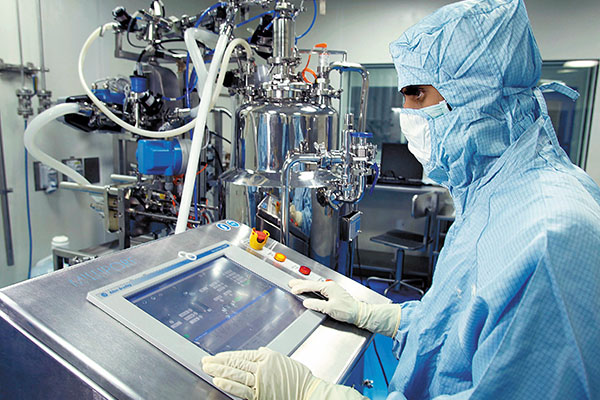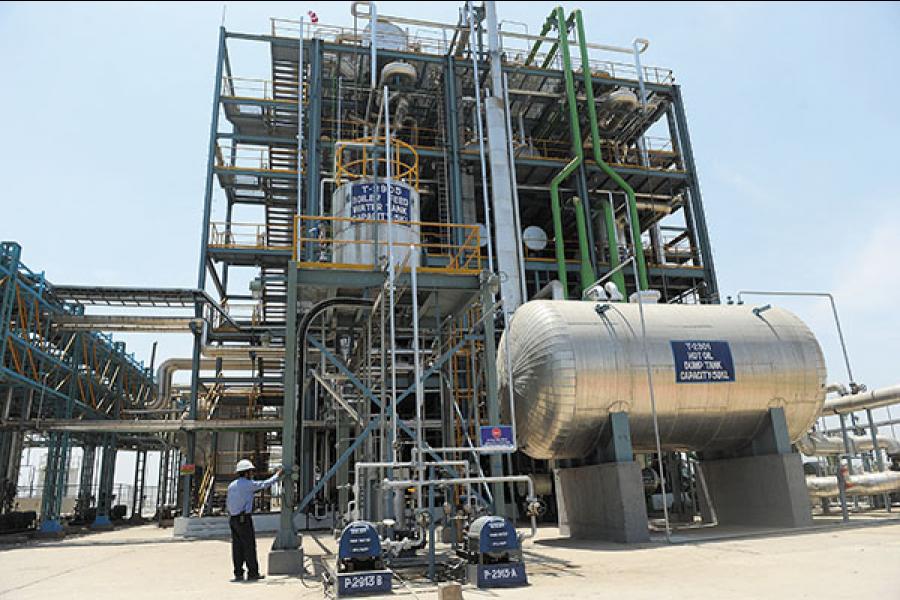
Kiran Mazumdar-Shaw: Not just make but also innovate in India
This is an opportunity for the government to fulfil its promise of revolutionising governance, pushing the economy towards recovery and improving India's credibility as a manufacturing base
 India needs Minister of Finance Arun Jaitley to deliver a path-breaking Union Budget, a bold statement that is visionary in scope yet granular in its objectives. It’s what is required to jumpstart an Indian economy that’s growing at nearly the slowest pace in a decade. While there are signs of a recovery on the back of favourable global macroeconomic developments, the GDP growth momentum remains weak as investments are yet to revive.
India needs Minister of Finance Arun Jaitley to deliver a path-breaking Union Budget, a bold statement that is visionary in scope yet granular in its objectives. It’s what is required to jumpstart an Indian economy that’s growing at nearly the slowest pace in a decade. While there are signs of a recovery on the back of favourable global macroeconomic developments, the GDP growth momentum remains weak as investments are yet to revive.
For a government that has come to power on the promise of revolutionising governance and pushing the economy towards recovery, this is an opportunity to take some long-pending, brave decisions. Investors are waiting for the Modi government to articulate second-generation economic reforms, give a thrust to the creation of world-class infrastructure, usher in overdue tax-, labour- and regulatory reforms and unveil business-friendly policies. Jaitley’s last budget was largely directional; this year’s will have to be about decisive action and a time-bound roadmap for economic revival.
Expectations are that the budget will provide more specifics on Prime Minister Modi’s ‘Make in India’ campaign. If successful, the PM’s global campaign to encourage investment and manufacturing in India can transform the country into an equitable and inclusive economic superpower.

A Biocon cancer drug facility in Bangalore. For India to retain its global leadership, investment in R&D is paramount
Realising ‘Make In India’
To translate ‘Make in India’ from a great slogan to an innovative economic growth mantra, we need enabling policies. For this, India will need to map the areas in which it has a competitive advantage over other popular manufacturing destinations like China. At a time when China is losing its attractiveness as a manufacturing destination because of rising production costs, India can highlight the fact that the combination of a strong and stable democratic government and the relatively free play of market forces make it a very attractive investment destination.
Moreover, nearly two-thirds of India’s 1.25 billion-strong population falls in the working age bracket, and that makes it an attractive manufacturing destination in terms of availability and cost of talent. This is a huge opportunity as an estimated 100 million jobs are expected to move out of China over the next few years in labour-intensive sectors, according to India’s National Manufacturing Competitiveness Council.
The economic mess of the past several years has left India’s manufacturing sector in the doldrums. Urgent action is needed to reverse the damage. The budget needs to spell out policies that will spur domestic manufacturing.
One of the ways to do it is by offering a weighted premium for indigenously manufactured products in government tenders. Several countries offer as high as 15 to 20 percent premium for locally-made products as part of their government procurement policies. In these countries, international manufacturers partner with local ones to avail of these preferential terms. It allows for technology transfers to the domestic industry, which then makes the product and bids for tenders. Such foreign collaborations can help Indian manufacturers significantly boost product quality levels and operational efficiencies, thus improving their competitiveness in global markets. Moreover, it will allow India to strengthen its manufacturing base, provide employment opportunities to millions and build a self-reliant nation.
We also need to improve the ease of doing business, reduce transaction costs and expedite approval timelines. It is unfortunate that India currently ranks a lowly 142nd out of 189 countries in the World Bank’s ‘Ease of Doing Business’ list. One of the steps that can facilitate this is the creation of a special cell within the Prime Minister’s Office, which will act as a one-stop shop to address the needs of overseas investors. PM Modi has already created a special Japan cell for fast-tracking investment proposals and addressing regulatory and operational impediments. This initiative needs to be expanded to include other important partner countries.
Local investors should also be given access to a ‘single window’ system for securing all clearances and approvals from the various central and state agencies. The current inordinately lengthy tiered approval system should be replaced with self-attestation and time-bound ‘deemed approvals’.
The government also needs to introduce policies that can tap into India’s entrepreneurial energy and encourage start-ups. Special incentives and tax exemptions will lead to the movement of ‘ideas to market’ and give momentum to the ‘Make in India’ initiative.
Infrastructure Push
To transform India into a global manufacturing hub, the government will need to improve infrastructure such as port-to-inland connectivity, cargo airports, uninterrupted power, adequate potable water, effective effluent treatment facilities and well-connected roads.
Moreover, the Special Economic Zones (SEZs) policy needs better implementation if it has to boost manufacturing and exports. SEZs need to be revived and revitalised. Simplification of operational norms through self-certification and the removal of the Minimum Alternate Tax (MAT) are some of the measures that will energise this ailing sector. Establishing smart cities and industrial corridors through high-end road and rail connectivity is also a key part of this plan.
The reality is that a ‘Made in India’ label today comes with huge credibility challenges in terms of quality, consistency and dependability. We need to build a new national narrative that corrects the negative global perception of India and highlights the core strengths and values that differentiate us from other nations.
Fundamental to this is the need to build a value proposition for India based on differentiation. We need to develop a national narrative around knowledge and wisdom that emanates from our centuries-old excellence in science and mathematics. We need to create a premium ‘Made in India’ label that personifies innovation, quality, reliability and strong IP [intellectual property]. Brand India should stand for ‘highest quality at lowest cost’.
Strengthening the Pharmaceutical Industry
As the largest and lowest-cost producer of generic drugs in the world, the Indian pharmaceutical industry has a crucial role to play in the government’s ‘Make in India’ initiative. The Indian pharma industry has earned the proud label of being the ‘Pharmacy of the World’ by creating a global scale manufacturing base, which has made our country an indispensable and integral part of global health care. It is imperative that we build and strengthen this sector so that it can assume an even greater position in global health care.
The budget needs to give the pharma industry a shot in the arm by ensuring the following:
Support to capital investment: Over the last decade, the top 20 Indian pharmaceutical companies have invested over Rs 25,000 crore in setting up global scale manufacturing facilities. These facilities need to be further augmented through exponential capital investment in the next 10 years. Many of these past investments have been done through high-interest domestic and overseas borrowings.
Foreign currency borrowings have resulted in huge liabilities on account of sharp rupee devaluation that has hurt the balance sheets of several of these companies. Low-interest borrowings need to be made available for future investments to be made by the pharmaceutical industry.
Incentives to ‘Innovate in India’: For India to retain its global leadership, investment in research and development (R&D) and innovation is paramount. The 200 percent weighted tax deduction on R&D costs allowed to pharmaceutical companies does not permit the inclusion of international patenting and overseas drug development expenses. This tax exemption should be allowed, urgently.
Rational approach to drug pricing: The computation of drug price ceilings should be based on an equitable formula, which ensures like-for-like comparisons and factors in the quantum of investments by pharma companies in creating world-class infrastructure. If pharmaceutical companies are prevented from deriving reasonable return on investments (RoIs), a draconian pricing policy will erode huge value for this all-important sector and make business unviable.
Incentives for Manufacturing: Unlike other sectors, the pharmaceutical industry needs international regulatory approvals before it can export drugs and drug ingredients.
The approval process takes an average of two years, denying all pharmaceutical units in SEZs the benefit of a tax holiday in that period. To address this anomaly, pharma SEZs should be allowed to avail of the tax holiday only after obtaining the required regulatory approvals. Additionally, the government should also consider the exemption of duties and taxes on domestic sales of essential drugs.
Increase in health care spending: This budget also provides an opportunity for the government to signal its commitment to universal health coverage. India needs to urgently raise public health care spending to at least 2.5 percent of the GDP from only about one percent currently. It also needs to create a highly effective, sustainable, technology-based universal health care system that emphasises individual responsibility for health supported by enabling state policy.
In conclusion, it’s worth noting that the prospect of a reforms-oriented budget has already started reflecting in market sentiments with the Sensex hitting record highs. To live up to investor expectations, the new government needs to introduce enabling policies as well as build the necessary infrastructure that supports the development agenda for the country across sectors.
This budget is a golden opportunity for the government to usher in the promised “achhe din [good days]” which will attest to the reformist credentials of the Narendra Modi-led government.
(This story appears in the 06 March, 2015 issue of Forbes India. To visit our Archives, click here.)
-
 Kiran Mazumdar-shaw
Kiran Mazumdar-shawThanks you all for your comments. Especially, Anantha and Swati who have given insightful inputs.
on Feb 23, 2015 -
 Dr.a.jagadeesh
Dr.a.jagadeeshExcellent article.
on Feb 23, 2015 -
 Anantha Ramaswamy
Anantha RamaswamyYes agree with the statement "not just make but also innovate". People are India's greatest asset. An organisation introduce a creative environment in which people are encouraged to speak up to provide suggestions on improvement of the processes and discuss new ideas will be successful in the innovation. Innovation does not necessarily had to derive from one individual but it also could happen within team of people.
on Feb 22, 2015 -
 Swati Sharma
Swati SharmaEverybody is waiting for the Budget, especially the lower middle class people . As the government has promised us that "Achhe din aane wale hain ", so we are hoping that budget is planned in a way which will increase the productivity of our country and hence give employment to people.
on Feb 20, 2015















